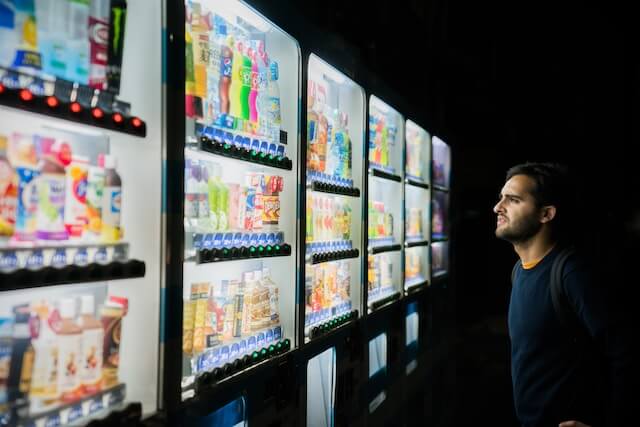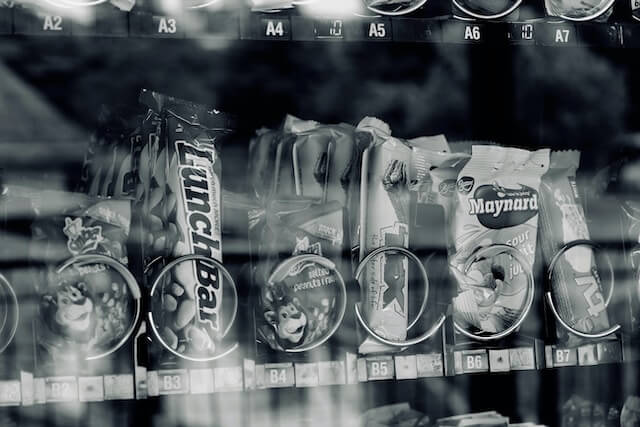Let’s show you how to write an effective vending machine business plan. No doubt, we now live in a dynamic world where there are many sides to being an entrepreneur. If you are looking to become your own boss and follow the entrepreneurship route, then you might want to consider starting a vending machine business.
As the demand for convenient, on-the-go products continues to rise; vending machines provide a practical and profitable solution. And that makes it an attractive business anyone can consider. However, like any successful venture, a well-thought-out business plan is essential to navigate the path towards prosperity.
But what are the elements you should include in your vending machine business plan? In this post, we will be showing the important elements your business plan should have and how to put them all together to make an effective business plan. What more? We will also show you a vending machine business plan sample you can leverage to create one for your business too.
Table of Contents
But Why Do You Need a Business Plan for This Business?
A solid business plan serves as the cornerstone for any successful venture, and starting a vending machine business is no exception. It acts as a roadmap, guiding entrepreneurs through the intricacies of their business, while providing a clear vision and direction.
A well-crafted business plan enables you to make informed decision regarding product selection, pricing strategies, and location choices. It also helps you stay focused and accountable because you would have already figured out your goals and objectives while writing your business plan, making the business journey much easier.
How to Create an Effective Vending Machine Business Plan: All You Need to Include In the Plan

To create an effective vending machine business plan, it is crucial to include key elements that provide a comprehensive overview of your venture. Each section serves a specific purpose in shaping your strategy and demonstrating your business’s viability. Let’s explore the essential elements to include:
#1: Executive Summary
The executive summary provides a concise overview of your entire business plan. It should highlight the key points, including your business concept, target market, competitive advantage, and financial projections. Although placed at the beginning, it is advisable to write the executive summary after completing the rest of the plan.
#2: Company Overview
In this section, outline the mission, vision, and goals of your vending machine business. Describe your company’s legal structure, location, and history. Discuss your unique selling proposition (USP) and the specific products or services your vending machines will offer.
#3: Industry Analysis
Conduct a thorough analysis of the vending machine industry, including market trends, growth potential, and any regulatory factors. Identify your target market segment and demonstrate a clear understanding of its demographics, preferences, and needs.
#4: Customer Analysis
Describe your target customers in detail, including their preferences, purchasing behaviors, and pain points. Highlight how your vending machine business will address their needs and provide convenience and value.
#5: Competitive Analysis
Assess the competitive landscape by identifying and analyzing existing vending machine businesses and potential competitors. Evaluate their strengths, weaknesses, and market positioning. Showcase how your business will differentiate itself and gain a competitive edge.
#6: Marketing Plan
In this section, outline your marketing strategies to attract and retain customers. Include details about branding, pricing, promotions, and distribution channels. Discuss how you will leverage digital marketing, social media, and other advertising methods to reach your target audience.
#7: Operation Plan
Provide a detailed plan for operating your vending machine business. Describe the logistics of machine procurement, inventory management, maintenance, and restocking. Explain how you will ensure product quality, freshness, and customer satisfaction.
#8: Management Team
Introduce the key members of your management team and their relevant experience. Highlight their roles and responsibilities within the organization. Investors and lenders want to see a capable team that can execute the business plan effectively.
#9: Financial Plan
Present a comprehensive financial forecast for your vending machine business. Include projected income statements, balance sheets, and cash flow statements. Demonstrate your understanding of start-up costs, revenue streams, and profitability expectations.
#10: Appendix
In the appendix, include supporting documents, such as market research data, permits, licenses, contracts, resumes of key team members, and any other relevant information that adds credibility to your plan.
Vending Business Plan Sample: An Easy-to-Use Template

To bring the home better, let’s show you a vending business plan sample or template that will illustrate how everything we have been saying plays out. In this section, we will be creating an imaginary company called “SnackEase” that operates in the vending machine industry. Then we will write a business plan for the company.
So, if you will be using this sample, perhaps for an urgent or deadline submission, you will need to edit SnackEase to your company name.
Executive Summary:
SnackEase aims to revolutionize the vending machine industry by offering a wide range of healthy snacks and beverages conveniently accessible to customers. With a focus on quality, convenience, and innovation, SnackEase seeks to capture a significant market share by targeting health-conscious individuals seeking on-the-go options. Our robust marketing strategies, efficient operations, and commitment to customer satisfaction will propel SnackEase to become a leader in the industry.
Company Overview:
SnackEase is a Delaware-based limited liability company. Our headquarters will be located in a high-traffic area in downtown Wilmington. We plan to start with a fleet of 50 state-of-the-art vending machines equipped with advanced payment systems and real-time inventory tracking.
Industry Analysis:
The vending machine industry is experiencing steady growth, with a market size projected to reach $12.5 billion by 2025. Shifting consumer preferences towards healthier snacks and the demand for convenient, on-the-go options provide ample opportunities. SnackEase will capitalize on this trend by curating a diverse product selection of nutritious snacks, organic beverages, and allergen-free options.
Customer Analysis:
SnackEase will serve large businesses within a 100-mile radius of our location. These potential customers are about 890 businesses with 100 or more employees.
Sectors with high potential are:
- 138 large businesses in the Retail sector
- 99 large businesses in the Manufacturing sector
- 75 large businesses in the Health Care sector
- 72 large businesses in the Professional, Scientific, and Technical Services sector.
Competitive Analysis:
SnackEase faces competition from existing vending machine operators and nearby convenience stores. The following vending machine operators are located within reasonable driving distance of SnackEase, thus providing either direct or indirect competition for customers:
Big Top Vending
Big Top Vending is a full-service vending company supplying state-of-the-art vending machines stocked with snacks, beverages, fresh and frozen foods, along with coffee vending machines and office coffee service.
In addition to traditional vending machines, the company offers a complete self-checkout vending market. It offers traditional vending services, as well as subsidized and free vending options to employers. Big Top helps customize selections to fit the location, and continually monitors the machines to make sure that they are fully stocked with the items that are bought most frequently.
Big Top Vending is the largest vending machine operator in the area. Its sheer size, along with its brand recognition will likely continue to attract loyal customers. However, our advantage lies in the fact that we are local, and can provide faster service for our customers.
Marketing Plan:
SnackEase will employ a multi-faceted marketing approach to maximize brand exposure and attract customers. This includes a strong online presence, social media advertising campaigns, targeted promotions, and collaborations with fitness centers and corporate offices.
Additionally, we will utilize data-driven analytics to refine our marketing strategies and tailor them to specific customer preferences.
Operation Plan:
SnackEase will carry out its day-to-day operations primarily on an appointment basis. In order to execute on SnackEase’s business model, the Company will perform many functions, including the following:
Sales Functions
- Machine placement negotiations
- Customization of product offerings
- Stocking the machines
Administrative Functions
- General & administrative functions, including legal, marketing, bookkeeping, etc.
- Sourcing and storing products
- Hiring and training staff
- Customer service
Miscellaneous
- Maintenance
Management Team:
SnackEasy is led by [Founder’s Name], who has been in retail management for 20 years. While [Founder] has never run a vending operation himself, he has managed convenience stores for 20 years.
As such, [Founder] has an in-depth knowledge of the convenience/grab-and-go food service business (e.g., running day-to-day operations) and the business management side (e.g., staffing, marketing, etc.).
[Founder] graduated from xyz University with a major in Business Administration. [Other person’s name] will serve as the customer service manager. He/she has extensive experience in the hospitality industry.
Financial Plan:
The financial plan projects revenue of $500,000 in the first year, with an estimated net profit margin of 15%. Start-up costs, including machine acquisition, initial inventory, and marketing expenses, are estimated at $300,000.
SnackEase plans to secure funding through a combination of equity investment and small business loans. The financial plan also includes a detailed three-year projection, demonstrating steady growth and profitability.
Appendix:
The appendix includes market research data on consumer trends, sample vending machine location agreements, product catalogs, and the resumes of key team members.
You may also intrested in other business plans:
Vending Business Tips to Help You Succeed
- Location is Key: Choose high-traffic locations with a target audience that aligns with your product offerings. Consider office buildings, universities, gyms, and hospitals for maximum visibility and customer engagement.
- Product Variety: Offer a diverse range of products to cater to different customer preferences. Include healthy snacks, beverages, and popular brands to appeal to a broader customer base.
- Monitor Trends: Stay updated on current consumer trends and adjust your product selection accordingly. Introduce new items, seasonal offerings, and limited editions to keep customers interested and coming back for more.
- Regular Maintenance: Ensure proper maintenance and cleanliness of your vending machines. Regularly restock inventory, conduct routine inspections, and promptly address any technical issues to provide a seamless customer experience.
- Marketing and Promotion: Implement effective marketing strategies to increase awareness and drive sales. Utilize social media, online advertising, and collaborations with local businesses to reach your target audience and create brand recognition.
- Customer Service: Prioritize exceptional customer service. Train your staff, if applicable, to be friendly, knowledgeable, and responsive to customer inquiries or concerns. Promptly address any customer feedback or complaints to maintain a positive reputation.
- Utilize Technology: Embrace technology to enhance efficiency and convenience. Implement cashless payment systems, digital signage, and real-time inventory tracking to streamline operations and improve the customer experience.
- Data Analysis: Take advantage of data analytics tools to gain insights into customer preferences and peak selling times. Use this information to optimize product placement, inventory management, and marketing strategies.
- Continuous Innovation: Stay ahead of the competition by continuously innovating and adapting to changing market dynamics. Explore new product offerings and vending machine technologies to stay relevant and meet evolving customer needs.
FAQs
What Tool Should I Use to Write My Vending Machine Business Plan?
When writing your vending machine business plan, you can use popular tools like Microsoft Word, Google Docs, or other word processing software. These tools provide a user-friendly interface and essential features to format and structure your plan effectively.
How Do I Market My Vending Machine Business?
There are a couple of ways you can market your vending machine business. One of them is establishing a professional website and creating social media profiles to showcase your products, locations, and promotions.
You can also collaborate with local businesses, offices, schools, and fitness centers to place your vending machines in their establishments. Offer them incentives and mutually beneficial arrangements to expand your reach.
You can as well take advantage of targeted advertising, direct mail marketing, and offering promotions and discounts. All these can be a great way for you to market your business and help it achieve its goals easily.
How Much Electricity Does a Vending Machine Use?
Vending machines designed for serving cold beverages typically consume an average of 7 to 14 kilowatt-hours (kWh) of electricity per day. The energy usage can vary based on factors such as the machine’s size, complexity, and additional features.
Smaller or simpler vending machines tend to have lower electricity consumption, closer to the range of 7 kWh. However, larger and more elaborate machines with additional functionalities may consume closer to the higher end of 14 kWh.
What Type of Vending Machines Make the Most Money?
Bulk machines, which are commonly found in playgrounds, parks, and restaurant waiting areas, are known to be one of the most affordable types of vending machines with significant profit margins.
These low-tech dispensers, often filled with gumballs, candies, and small toys, offer a cost-effective option for entrepreneurs looking to enter the vending machine business. The bulk machines’ appeal lies in their simplicity, low maintenance requirements, and high-profit potential.
How Much Money Do Vending Machines Make?
Vending machines can be a lucrative source of revenue. The initial cost of a vending machine, including equipment and shelving, ranges from $3,000 to $5,000. Annual maintenance and stocking expenses can amount to a few thousand dollars.
On average, vending machines have a profit margin of around 50%, meaning that half of the money spent on products is profit.
















